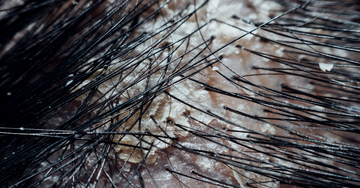Let’s Talk About Scalp Dermatitis – From a Trichologists' Chair
When I’m analysing a scalp that’s itchy, flaky, red, or inflamed, one of the most common culprits I see is seborrheic dermatitis. And if that’s what you're dealing with, I want to walk you through exactly what’s happening on your scalp, because understanding why it’s happening is the first step to calming it down.
What Exactly Is Seborrheic Dermatitis?
Seborrheic dermatitis is a chronic inflammatory condition that affects areas rich in sebaceous (oil) glands, so the scalp is a prime target. It often presents with oily-looking flakes, redness, and itchiness. But this isn’t about dry skin or "needing to wash your hair more often" it’s a little more complex than that.
The root cause involves a yeast called Malassezia, which naturally lives on all of our skin. But on certain people (roughly 50% of the population), this yeast triggers a reaction. Here’s how it works:
-
Malassezia feeds on your natural scalp oils (sebum).
-
As it breaks those oils down, one of the by-products is oleic acid.
-
In people with a genetic sensitivity, that oleic acid disrupts the scalp’s barrier and causes inflammation.
-
The result? Itch, flakes, redness, and in some cases, even small patches of hair loss if left untreated.
This sensitivity can be genetic, but it’s also affected by diet, stress, hormones, weather changes, and even the products you use. So while it’s a condition that comes from within, it definitely responds to what’s happening around you, too.
What I See When I Look at a Scalp with Dermatitis
When I part the hair and start analysing the scalp, here’s what I’m looking for:
-
Texture: The scales are thin, soft, and can look slightly greasy. They lift easily and often mix with sebum, which can make the hair appear oily even just a day after washing.
-
Colour: On lighter skin, you’ll often see redness. On deeper skin tones, it might show up as lighter or darker patches. The flakes themselves tend to be white or yellowish.
-
Feeling: Clients often describe it as relentlessly itchy, sometimes burning or feeling tight. It’s usually not painful, but it’s incredibly uncomfortable.
Associated Areas
Scalp dermatitis doesn’t always stay confined to the scalp. During consultations, I often see signs of it extending to other areas with a high density of sebaceous glands. The most commonly affected zones include:
-
Nasolabial folds – the creases around the nose and mouth
-
Eyebrows – particularly in the inner corners and arch
-
Behind the ears – often missed but frequently affected
-
Upper chest – especially in the centre where oil levels are higher
-
Eyelashes/lash line – showing as mild flaking or irritation
These areas tend to mirror what's happening on the scalp and can flare up in tandem, especially during seasonal changes, periods of stress, or when the skin barrier is compromised. If you're seeing flaking or redness in any of these zones alongside scalp symptoms, it’s all part of the same underlying issue and worth addressing holistically.
Internal Triggers: How Diet and Lifestyle Play a Role
I always ask my clients about their diet, digestion, stress levels, and sleep, because all of these can influence the severity of flare-ups.
Some science-backed ways to reduce inflammation and help restore skin balance include:
-
Omega-3 Fatty Acids – Think flaxseeds, chia seeds, walnuts, and algae-based oils. These help calm inflammation at a cellular level.
-
Antioxidants – Berries, leafy greens, sweet potatoes... these support the skin’s natural repair processes.
-
Probiotics – A healthy gut supports healthy skin. Fermented foods like sauerkraut, kimchi, and kefir (or dairy-free alternatives) can be beneficial.
-
Hydration – The scalp is skin. Dehydration compromises its barrier, so aim for those 8+ glasses daily.
-
Reduce Oleic Acid–Heavy Oils – If you’re prone to dermatitis, reducing internal and topical sources of high-oleic oils (like olive oil or coconut oil) may help prevent flare-ups.
What I Recommend in a Scalp Care Routine
Here’s how I build a plant-based, barrier-supporting routine that mimics what the scalp needs, while calming inflammation and restoring balance:
Step 1: Cleanse Gently, but Effectively
Choose a sulphate-free shampoo with a pH close to that of your scalp (around 4.5–5.5). Our Stimulate and Strengthen Shampoo contains plant extracts that soothe, balance, and support the skin barrier. We’ve also included ingredients like zinc, which helps reduce excess sebum and gently manage yeast levels without stripping the skin.
Step 2: Use a Conditioner That Supports Scalp Health
People often skip conditioner when dealing with flakes or oil, but this can leave the skin dry and irritated. Our Strengthen and Shine is formulated with low oleic oils like hempseed, grapeseed, and flaxseed—which hydrate without feeding Malassezia or clogging follicles.
"Remember: Malassezia doesn’t cause dandruff on its own, it’s the by-product of its digestion process (oleic acid) that sparks inflammation. That’s why we focus on ingredients that nourish without adding fuel to the fire."
Step 3: Add a Targeted Scalp Treatment
Once or twice a week, I recommend using a pre-shampoo treatment. Ingredients I love for this include:
-
Blue spirulina – Naturally antimicrobial and high in zinc.
-
Allantoin – Soothes itching and has antifungal properties.
-
Colloidal oatmeal – Relieves irritation and supports the skin barrier.
Our Rejuvenate Dust can be mixed into oils, shampoo, or conditioner for a fully customisable treatment depending on how your scalp is behaving that week.
Step 4: Moisturise and Protect
Don’t forget the scalp after washing. Our Revitalise Serum is a non-greasy, barrier-repairing formula that calms redness, hydrates deeply, and promotes healthy follicle function, without causing buildup or weighing the hair down.
Step 5: Choose Styling Products Wisely
Avoid heavy, synthetic-laden styling products that can clog follicles or leave residue. Instead, opt for lightweight, plant-based alternatives that help the scalp breathe while supporting your style.
Step 6: Low-Level Light Therapy (LLLT)
Incorporate red or blue light therapy into your scalp routine 3–4 times per week to help manage scalp dermatitis. LLLT is a non-invasive treatment that uses specific wavelengths of light to reduce inflammation, balance oil production, and promote healing of the skin barrier.
-
Red light (630–660nm) penetrates deeper into the skin and is known for reducing inflammation, supporting tissue repair, and encouraging cellular turnover.
-
Blue light (around 415nm) is ideal for targeting the yeast Malassezia, which contributes to seborrheic dermatitis and dandruff. It also has antimicrobial properties that help reduce scalp irritation and buildup.
Use your LLLT device on a clean scalp, ideally after your shampoo and conditioner, when the scalp is most receptive. A typical session lasts around 10–20 minutes, depending on your device, and should be done consistently for the best results.
LLLT helps:
-
Reduce redness, swelling, and flaking
-
Rebalance oil production
-
Support a stronger scalp barrier over time
Pairing light therapy with your plant-based topical treatments enhances absorption and efficacy, giving your scalp the best chance to calm and heal naturally.
Environmental & Lifestyle Triggers to Watch
-
Heat styling: High heat can inflame an already compromised scalp.
-
Hard water or harsh weather: Can dry the scalp and worsen flaking.
-
Stress & hormones: Major players in skin inflammation, especially during PMS, postpartum, or perimenopause.
-
Sleep & screen time: Poor sleep and late-night scrolling increase cortisol and oxidative stress, which shows up on the skin.
Final Thoughts: This Is Manageable
Seborrheic dermatitis is incredibly common, but that doesn’t mean you have to live with it. With the right support, your scalp can absolutely find balance again. If you’re unsure whether what you’re experiencing is dermatitis, feel free to reach out. I offer personalised scalp assessments to help you get to the root of what’s going on, and build a plan that actually works for you.
Whether it’s through your inbox or in clinic, I’m here to support your scalp health journey.





